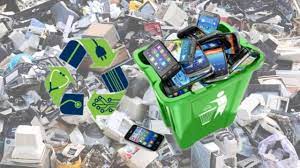
E-waste

19.12.2023
E-waste , Daily Current Affairs , RACE IAS : Best IAS Coaching in Lucknow
|
For Prelims: What is e-waste,Important points,E-waste in India For Mains Paper: Steps taken by the Government of India |
Why in the news?
More than 500,000 tonnes of e-waste was collected and processed in 2021-22, it was reported in a recent reply in the Indian Parliament.
Important points:
- 527,131.57 tonnes of e-waste was collected, destroyed and recycled in the financial year 2021-22, Union Minister of State for Environment, Forest and Climate Change Ashwini Kumar Choubey told the Rajya Sabha.
- The Central Pollution Control Board (CPCB) estimates e-waste generation at the national level based on nationwide sales data provided by producers.
What is e-waste:
- Waste electrical and electronic items are called e-waste.
- Electronic waste (e-waste) is a general term used to describe all types of old, worn out or discarded electrical and electronic equipment, such as home appliances, office information and communication equipment, etc.
- E-waste contains many toxic chemicals including metals such as lead, cadmium, mercury and nickel.
E-waste in India:
- 65 cities in India generate more than 60% of the total e-waste generated while 10 states generate 70% of all e-waste.
- Bangalore, Chennai, Kolkata, Ahmedabad, Hyderabad, Pune, Surat and Nagpur are other important cities that generate substantial amounts of e-waste.
- Among the eight largest states generating e-waste, Maharashtra ranks first, followed by Tamil Nadu. Andhra Pradesh (3rd), Uttar Pradesh (4th), Delhi (5th), Gujarat (6th), Karnataka (7th), and West Bengal (8th).
- More than half of the e-waste generated in the developed world is exported to developing countries, primarily China, India and Pakistan, where metals such as copper, iron, silicon, nickel and gold are recovered during the recycling process. Are going.
- Unlike developed countries, where facilities have been built specifically for recycling e-waste, recycling in developing countries often involves manual involvement, putting workers at risk. For toxic substances present in e-waste.
Steps taken by the Government of India:
- The Central Government had notified the E-Waste Management Rules, 2016 in exercise of the powers conferred under the Environment (Protection) Act, 1986.
- These rules replace the E-Waste (Management and Handling) Rules, 2011.
- Its objective is to enable recovery and reuse of useful materials from e-waste, and to ensure environmentally sound management of all types of waste from electrical and electronic equipment.
- For the first time, the rules brought manufacturers under the Target Extended Producer Responsibility (EPR).
- Producers have been made responsible for the collection and disposal of e-waste.
- Manufacturers, dealers, e-retailers and refurbishers have been brought under the ambit of these rules to ensure that e-waste is managed and disposed of effectively.
- The Ministry has comprehensively amended the E-Waste Management Rules, 2016 and notified the E-Waste (Management) Rules, 2022 in November, 2022 and it has come into effect from April 1, 2023.
- These new rules aim to manage e-waste in an environmentally sound manner. An improved Extended Producer Responsibility (EPR) regime for e-waste recycling was implemented, wherein all manufacturers, producers, refurbishers and recyclers are required to register on the portal developed by CPCB.
- An action plan to enforce e-waste (management) rules is in place across the country and is being implemented by all States/UTs and State Pollution Control Boards (SPCBs)/Pollution Control Committees (PCCs).
An e-waste management review portal has also been developed to upload the status and progress of the e-waste action plan.